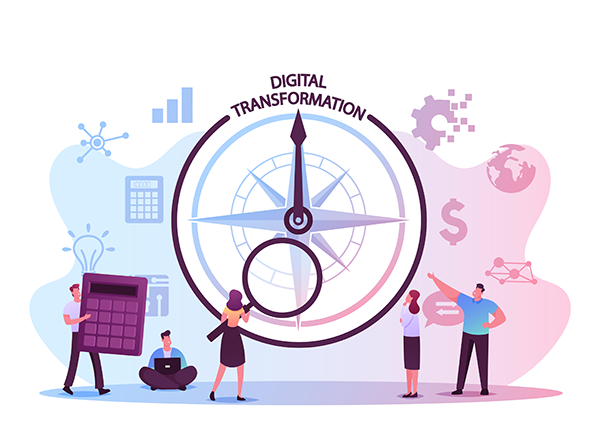In today’s world, digital transformation is no longer an option. Instead, it is a necessity for businesses to stay competitive. The rapid pace of technological advancements, coupled with changing consumer behavior and expectations, has forced companies to rethink their strategies and embrace digital transformation. In fact, a recent study by McKinsey & Company found that companies that fully embrace digital transformation are 1.5 times more likely to achieve above-average financial performance than those that do not. As a first step, a digital transformation framework is essential to survive disruption and provide new and improved products and services. Embracing exciting technologies and using the latest technologies like augmented reality can create unrivaled efficiencies and enhance current processes.
Digital transformation frameworks provide strategies to navigate the ever-changing digital landscape. By using the current technologies, businesses can create transformation that benefits not only their organization but also their customers.
Developing integrated strategies can improve leaders’ and employee performances while achieving internal collaboration to see measurable benefits. Change management is also a key point in this digital transformation framework, as it plays a vital role in the success of the entire digital transformation journey.
By focusing on the customer journey, businesses can develop a digital transformation framework that addresses core points while creating value for both customers and their organization. However, a global revolution in this direction requires many enterprises to adopt transformation strategies that align with their specific requirements. For your company to achieve true transformation requires an entire culture shift that involves all members of the organization.
The First Steps: Goal-Setting and Team Building
Your digital evolution requires a comprehensive plan that moves your entire business toward a fresh and exciting setting. This inclusive transformation leverages technology and people to achieve new processes and innovate plans, and ensures that strategy is always at the forefront.
Many organizations have already transformed their business by implementing digital technology, but there is still much work to be done. The most mature organizations understand that a strategic digital framework is necessary to identify areas where they can take advantage of the benefits of digital transformation.
However, creating an industry-unique needs-based framework requires practical steps and a process that takes a closer look at the organization’s unique challenges and opportunities.
Using technology as a tool, you can develop a framework that aligns with your business objectives and enables you to fully embrace digital transformation:
- The first step is developing a plan or a strategy describing how technology can be used effectively to drive innovation, streamline processes, and improve customer experiences.
- Marketers, technologists, and leaders need to work together to develop a framework that addresses specific challenges and demands. The leaders or significant team members should provide the blueprint or formal plan that emphasizes strategic planning and eases integration, making the transition smoother for all employees.
- Take time to research and understand the potential value of new technology as well as anticipate future obstacles that may arise during implementation.
- It is important to avoid common mistakes, which include giving too much attention to specific technologies rather than creating a holistic strategy that considers current processes and systems processes.
- Include the detailed migration plan in the strategy document to seamlessly migrate the current technology for future success.
- The final goal of the strategy is leaving options open for new business models and new markets.
- Clearly defined goals, along with established milestones are necessary to see the project through. The best framework is one that aligns with your objectives and long-term strategy, while taking into consideration the business size, customers’ current digital maturity, and employees’ capabilities.
By developing a clear roadmap for implementing their strategy, businesses can bring their initiatives to life and ensure strategy success.
Developing a Digital Transformation Strategy: Step by Step
According to an online survey, 70% of businesses either have a transformation strategy in place or are planning one. For all the statistics buffs, this Forbes article will enlighten you about recent data gathered around digital transformation. However, the approaches and outcomes vary greatly depending on each company’s unique situation.
To successfully disrupt their industry, businesses must first understand their company’s current operating model and identify areas for improvement. Digital transformation case studies provide valuable insights into how other businesses have successfully implemented change.
By leveraging these existing case studies, business leaders can accelerate their own transformation journey and avoid common pitfalls. Here are some key elements of a digital transformation framework:
- Analyze the technology infrastructure that supports your business processes. This includes hardware, software systems, network architecture, data storage solutions, and security protocols.
- Assess the digital maturity of your business through frameworks and models such as the Capability Maturity Model Integration (CMMI) or Digital Maturity Model (DMM). These models provide a structured approach for evaluating different aspects of your organization’s digital readiness.
- Examine your organization’s processes to identify bottlenecks or inefficiencies that hinder productivity. Look for opportunities to streamline workflows using automation tools or emerging technologies such as AI or blockchain.
- Orient employees toward developing a mindset for shedding old procedures and adopting new digital processes, which requires company leaders to move their thinking toward change.
- Skilling employees is another critical aspect of the framework as it eases integration of new technologies and software platforms. With this approach, performance can be improved through more efficient teamwork, which leads to productivity efficiency gains.
- Analyze the company’s internal goals to identify value drivers that can help scale digital transformation projects.
- The term “business processes” is included in the transformation framework as it helps digital transformation by achieving internal collaboration while keeping business process optimization in mind.
- The core elements of a strong digital transformation strategy are leadership commitment, organizational structure, technology infrastructure, data strategy, talent management, and customer-centricity.
Summary
Digital transformation is not just about technology: It’s also about creating a digital culture that permeates all aspects of the organization. By focusing on technology, businesses can improve customer experiences, streamline processes, and create new business models.
However, developing a successful digital transformation framework requires addressing an organization’s specific challenges while balancing the needs of leaders, marketers, technology leaders, employees, and customers. Developing a digital transformation framework is crucial for businesses that want to stay relevant and competitive in today’s digital economy.
Image used under license from Shutterstock.com




